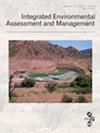Books and Other Reviews
IF 3
4区 环境科学与生态学
Q2 ENVIRONMENTAL SCIENCES
引用次数: 0
书籍和其他评论
本文章由计算机程序翻译,如有差异,请以英文原文为准。
求助全文
约1分钟内获得全文
求助全文
来源期刊

Integrated Environmental Assessment and Management
ENVIRONMENTAL SCIENCESTOXICOLOGY&nbs-TOXICOLOGY
CiteScore
5.90
自引率
6.50%
发文量
156
期刊介绍:
Integrated Environmental Assessment and Management (IEAM) publishes the science underpinning environmental decision making and problem solving. Papers submitted to IEAM must link science and technical innovations to vexing regional or global environmental issues in one or more of the following core areas:
Science-informed regulation, policy, and decision making
Health and ecological risk and impact assessment
Restoration and management of damaged ecosystems
Sustaining ecosystems
Managing large-scale environmental change
Papers published in these broad fields of study are connected by an array of interdisciplinary engineering, management, and scientific themes, which collectively reflect the interconnectedness of the scientific, social, and environmental challenges facing our modern global society:
Methods for environmental quality assessment; forecasting across a number of ecosystem uses and challenges (systems-based, cost-benefit, ecosystem services, etc.); measuring or predicting ecosystem change and adaptation
Approaches that connect policy and management tools; harmonize national and international environmental regulation; merge human well-being with ecological management; develop and sustain the function of ecosystems; conceptualize, model and apply concepts of spatial and regional sustainability
Assessment and management frameworks that incorporate conservation, life cycle, restoration, and sustainability; considerations for climate-induced adaptation, change and consequences, and vulnerability
Environmental management applications using risk-based approaches; considerations for protecting and fostering biodiversity, as well as enhancement or protection of ecosystem services and resiliency.
 求助内容:
求助内容: 应助结果提醒方式:
应助结果提醒方式:


